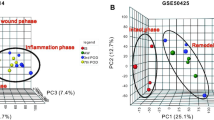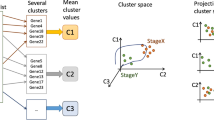Abstract
The identification of ante- and post-mortem burns is challenging in forensic pathology. In this study, microarray analysis was used to detect the mRNA expression profiles in the skin of an experimental burn mouse model; the results were validated using RT-qPCR. Differentially expressed mRNAs (DE-mRNAs) were assessed using the Gene Ontology (GO) and Kyoto Encyclopedia of Genes and Genomes (KEGG) databases. Our results revealed that mRNA expression of 501 genes was significantly different, of which 273 were upregulated and 228 were downregulated in ante-mortem burned mice skin. The expression levels of eight random mRNAs were consistent when measured using the microarray assay-based method and RT-qPCR. Genes from different functional categories and signalling pathways were enriched, including interleukin-20 binding, type IV hypersensitivity, negative regulation of acute inflammatory response, sensory organ development, endocytosis, neuroactive ligand-receptor interaction, and Jak-STAT signalling pathway. Only five of the eight mRNAs exhibited consistent changes in expression between burned skin samples of mice and human autopsy specimens. Our findings showed that DE-mRNAs revealed using microarray are potential biomarkers of ante-mortem burns. However, DE-mRNAs identified from experimental animal models cannot be directly extended to autopsy specimens without careful validation.






Similar content being viewed by others
References
Fanton L, Jdeed K, Tilhet-Coartet S, Malicier D. Criminal burning. Forensic Sci Int. 2006;158:87–93.
Esen Melez İ, Arslan MN, Melez DO, Gürler AS, Büyük Y. Manner of death determination in fire fatalities: 5-year autopsy data of Istanbul City. Am J Forensic Med Pathol. 2017;38:59–68.
Bohnert M, Werner CR, Pollak S. Problems associated with the diagnosis of vitality in burned bodies. Forensic Sci Int. 2003;135:197–205.
Oehmichen M. Vitality and time course of wounds. Forensic Sci Int. 2004;144:221–31.
Casse JM, Martrille L, Vignaud JM, Gauchotte G. Skin wounds vitality markers in forensic pathology: an updated review. Med Sci Law. 2016;56:128–37.
Li N, Du Q, Bai R, Sun J. Vitality and wound-age estimation in forensic pathology: review and future prospects. Forensic Sci Res. 2018;5:15–24.
Madea B, Doberentz E, Jackowski C. Vital reactions - an updated overview. Forensic Sci Int. 2019;305:110029.
Kubo H, Hayashi T, Ago K, Ago M, Kanekura T, Ogata M. Forensic diagnosis of ante- and postmortem burn based on aquaporin-3 gene expression in the skin. Leg Med (Tokyo). 2014;16:128–34.
Lyu HP, Cheng M, Liu JC, Ye MY, Xu D, He JT, Xie XL, Wang Q. Differentially expressed microRNAs as potential markers for vital reaction of burned skin. J Forensic Sci Med. 2018; https://www.jfsmonline.com/text.asp?2018/4/3/135/242507.
Cline MS, Smoot M, Cerami E, Kuchinsky A, Landys N, Workman C, Christmas R, Avila-Campilo I, Creech M, Gross B, Hanspers K, Isserlin R, Kelley R, Killcoyne S, Lotia S, Maere S, Morris J, Ono K, Pavlovic V, Pico AR, Vailaya A, Wang PL, Adler A, Conklin BR, Hood L, Kuiper M, Sander C, Schmulevich I, Schwikowski B, Warner GJ, Ideker T, Bader GD. Integration of biological networks and gene expression data using Cytoscape. Nat Protoc. 2007;2:2366–82.
Weis A, Bohnert M. Expression patterns of adhesion molecules P-selectin, von Willebrand factor and PECAM-1 in lungs: a comparative study in cases of burn shock and hemorrhagic shock. Forensic Sci Int. 2008;175:102–6.
Bohnert M, Anderson J, Rothschild MA, Böhm J. Immunohistochemical expression of fibronectin in the lungs of fire victims proves intravital reaction in fatal burns. Int J Legal Med. 2010;124:583–8.
Doberentz E, Genneper L, Wagner R, Madea B. Expression times for hsp27 and hsp70 as an indicator of thermal stress during death due to fire. Int J Legal Med. 2017;131:1707–18.
Reuter JA, Spacek DV, Snyder MP. High-throughput sequencing technologies. Mol Cell. 2015;58:586–97.
Soon WW, Hariharan M, Snyder MP. High-throughput sequencing for biology and medicine. Mol Syst Biol. 2013;9:640.
Christie JD. Microarrays. Crit Care Med. 2005;33(12 Suppl):S449–52.
Zhang K, Cheng M, Xu J, Chen L, Li J, Li Q, Xie X, Wang Q. MiR-711 and miR-183–3p as potential markers for vital reaction of burned skin. Forensic Sci Res. 2020. https://doi.org/10.1080/20961790.2020.1719454.
Xu J, Zhao R, Xue Y, Xiao H, Sheng Y, Zhao D, He J, Huang H, Wang Q, Wang H. RNA-seq profiling reveals differentially expressed genes as potential markers for vital reaction in skin contusion: a pilot study. Forensic Sci Res. 2018;3:153–60.
He JT, Huang HY, Qu D, Xue Y, Zhang KK, Xie XL, Wang Q. CXCL1 and CXCR2 as potential markers for vital reactions in skin contusions. Forensic Sci Med Pathol. 2018;14:174–9.
Qu D, Tan XH, Zhang KK, Wang Q, Wang HJ. ATF3 mRNA, but not BTG2, as a possible marker for vital reaction of skin contusion. Forensic Sci Int. 2019;303:109937.
Quan PQ, Li MZ, Wang GR, Gu LL, Liu XD. Comparative transcriptome analysis of the rice leaf folder (Cnaphalocrocis medinalis) to heat acclimation. BMC Genomics. 2020;21:450.
Rich BE. IL-20: a new target for the treatment of inflammatory skin disease. Expert Opin Ther Targets. 2003;7:165–74.
Rutz S, Wang X, Ouyang W. The IL-20 subfamily of cytokines–from host defence to tissue homeostasis. Nat Rev Immunol. 2014;14:783–95.
Ouyang W, Rutz S, Crellin NK, Valdez PA, Hymowitz SG. Regulation and functions of the IL-10 family of cytokines in inflammation and disease. Annu Rev Immunol. 2011;29:71–109.
Spies M, Nesic O, Barrow RE, Perez-Polo JR, Herndon DN. Liposomal IGF-1 gene transfer modulates pro- and anti-inflammatory cytokine mRNA expression in the burn wound. Gene Ther. 2001;8:1409–15.
Bylund DB, Eikenberg DC, Hieble JP, Langer SZ, Lefkowitz RJ, Minneman KP, Molinoff PB, Ruffolo RRJ, Trendelenburg U. Pharmacol Rev. 1994;46:121–36.
Hall RA. Beta-adrenergic receptors and their interacting proteins. Semin Cell Dev Biol. 2004;15:281–8.
Philipp M, Hein L. Adrenergic receptor knockout mice: distinct functions of 9 receptor subtypes. Pharmacol Ther. 2004;101:65–74.
Xu H, Rajsombath MM, Weikop P, Selkoe DJ. Enriched environment enhances β-adrenergic signaling to prevent microglia inflammation by amyloid-β. EMBO Mol Med. 2018;10:e8931.
Ristori C, Filippi L, Dal Monte M, Martini D, Cammalleri M, Fortunato P, la Marca G, Fiorini P, Bagnoli P. Role of the adrenergic system in a mouse model of oxygen-induced retinopathy: antiangiogenic effects of beta-adrenoreceptor blockade. Invest Ophthalmol Vis Sci. 2011;52:155–70.
Zhu X, Bührer C, Wellmann S. Cold-inducible proteins CIRP and RBM3, a unique couple with activities far beyond the cold. Cell Mol Life Sci. 2016;73:3839–59.
Al-Astal HI, Massad M, AlMatar M, Ekal H. Cellular functions of RNA-binding motif protein 3 (RBM3): clues in hypothermia, cancer biology and apoptosis. Protein Pept Lett. 2016;23:828–35.
Funding
This work was supported by the National Natural Science Foundation of China (81871526, 81971796) and Beijing Natural Science Foundation (7192121).
Author information
Authors and Affiliations
Contributions
Jia-Li Liu: Methodology, investigation, formal analysis, and writing—original draft. Ye-Hua Zheng: Methodology, data curation, formal analysis, and writing—original draft. Li-Jian Chen: Investigation and validation. Kai-Kai Zhang: Data curation and visualization. Jia-Hao Li: Project administration and data curation. Jian-Zheng Yang: Formal analysis. Xiu-Wen Li: Resources. Dong Zhao: Funding acquisition and supervision. Xiao-Li Xie: Funding acquisition, methodology, project administration, and supervision. Qi Wang: Funding acquisition, conceptualization, and writing—review and editing.
Corresponding authors
Ethics declarations
Ethical approval
Approval was obtained from the ethics committee of the Southern Medical University. The procedures used in this study adhere to the tenets of the Declaration of Helsinki.
Conflict of interest
The authors declare no competing interests.
Additional information
Publisher's Note
Springer Nature remains neutral with regard to jurisdictional claims in published maps and institutional affiliations.
Supplementary information
Below is the link to the electronic supplementary material.
Rights and permissions
About this article
Cite this article
Liu, JL., Zheng, YH., Chen, LJ. et al. mRNA microarray analysis for the identification of potential biomarkers for vital reaction in burned skin: a preliminary pilot study. Forensic Sci Med Pathol 18, 319–328 (2022). https://doi.org/10.1007/s12024-022-00474-5
Accepted:
Published:
Issue Date:
DOI: https://doi.org/10.1007/s12024-022-00474-5




